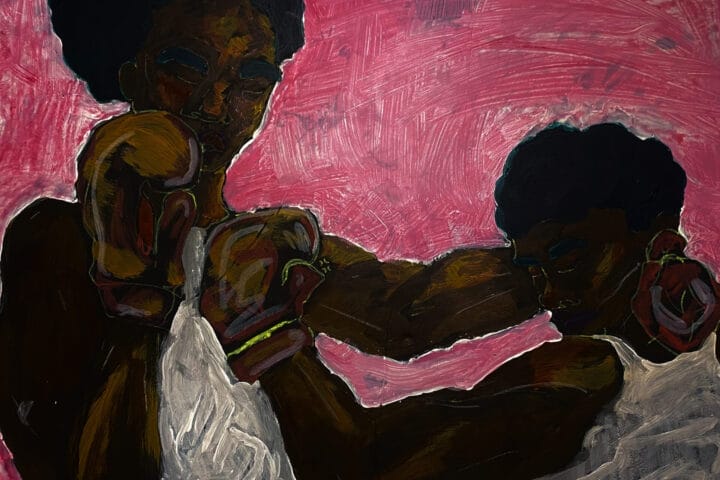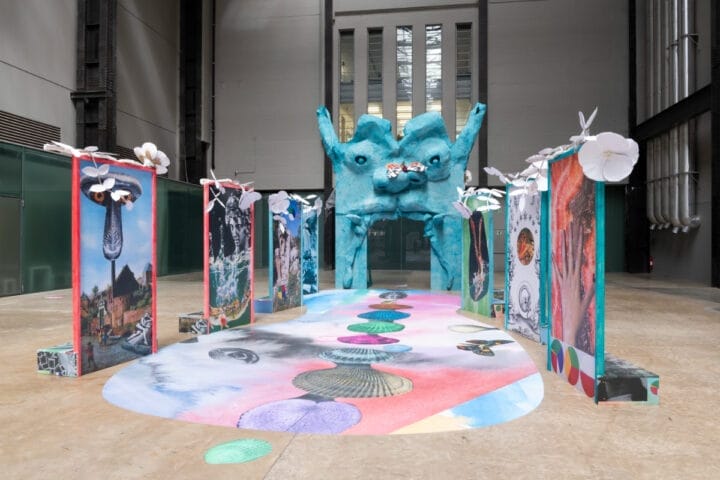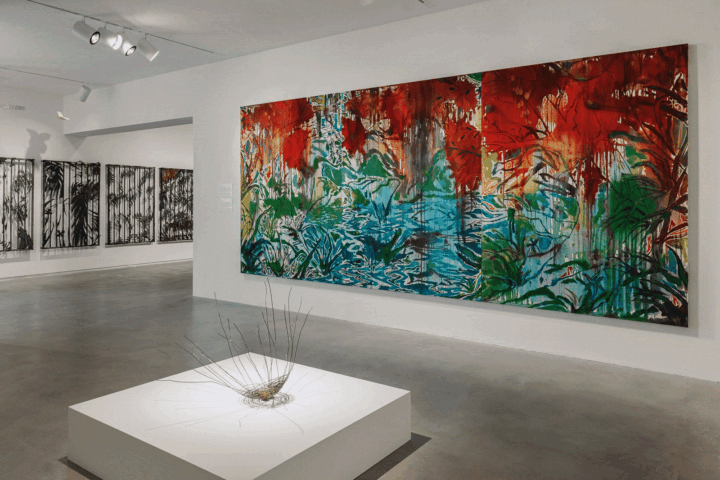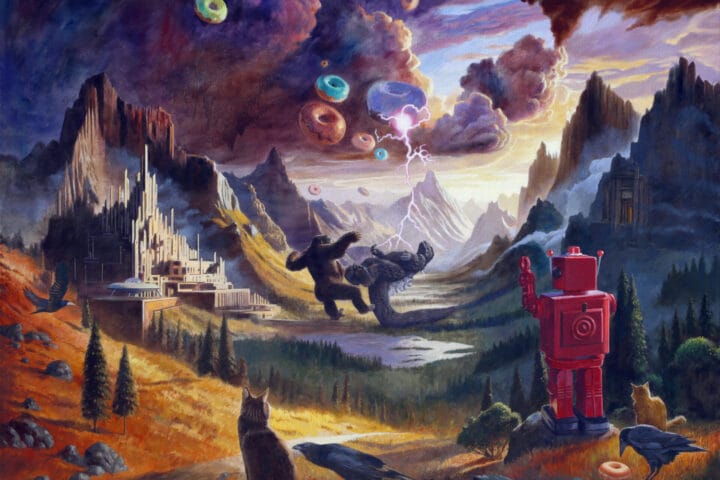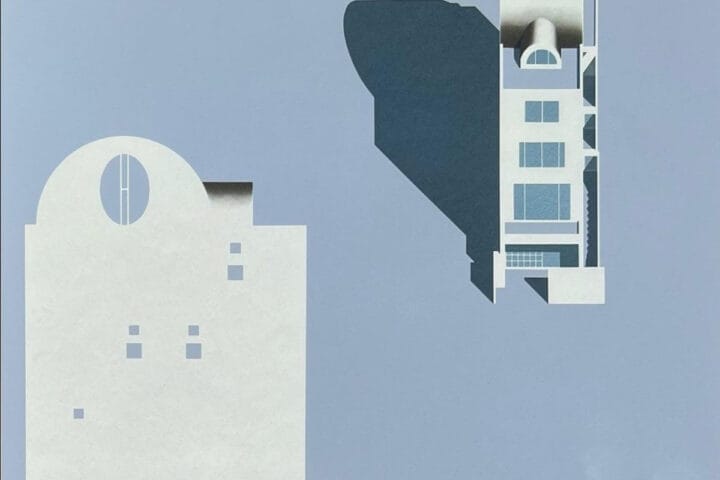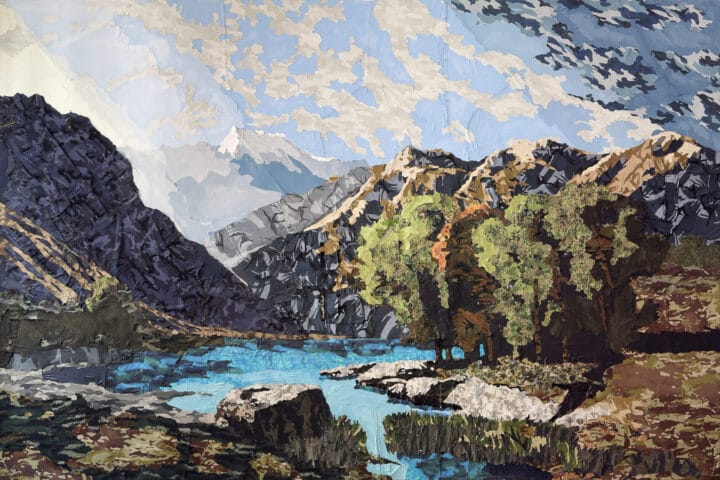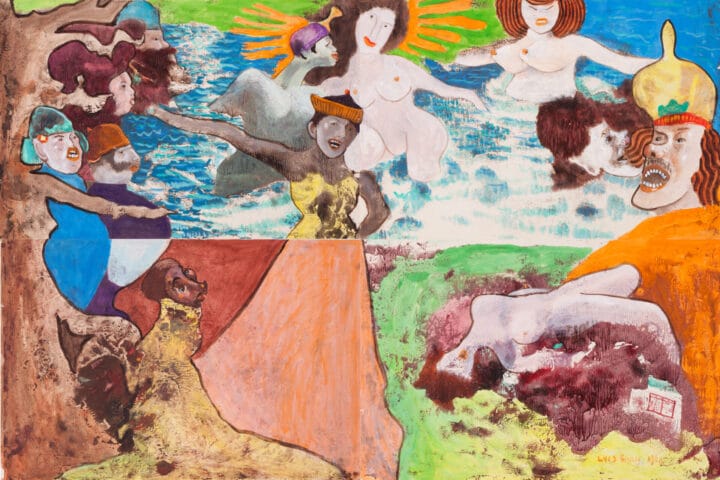“I find that the knot is the beginning of everything. Everything is accidental to me. An accident becomes a work.”
The renowned Colombian artist Olga de Amaral opens her first solo show in London for almost a decade, following her inaugural exhibitions with Lisson Gallery in New York last year. This display of cascading, layered textiles and numinous clouds of hanging strands, among a range of other historic and recent pieces, reveals Amaral’s mastery of the loom and the woven language, but also the ways in which her practice crosses over into painting, sculpture and installation – being as much fine art as fibre art. While a recent touring museum exhibition in the US, entitled ‘To Weave a Rock’, introduced her to many new audiences, her work is seldom seen in such great depth in Europe, despite many of her earliest influences emanating from her travels and influences encountered here and elsewhere, between the 1950s and ’70s.
Most of the works in this show hail from the past two decades, featuring her characteristic intertwined surfaces of linen or another base material warp, which is then encrusted in gesso and even adorned with gold leaf or palladium, transforming the simplest of supports into shimmering walls of indeterminate, alchemical matter. A centrepiece of the presentation is a cascading installation of layered polyurethane entitled Luz Blanca (White Light, 1969), an early work in which Amaral experimented with sheets of plastic, being drawn to its flexible and contemporary nature, as well as the iridescent surface reflections. Similarly experiential in nature are her cloud-like Brumas (Mists, 2014), in which three-dimensional coloured forms seem to appear within gathered skeins of thread, a technique Amaral has likened to “painting in space”. While resolutely handmade objects, Amaral’s works do often seem to contain or conjure natural motifs from within themselves, perhaps recalling waterfalls (in Umbra Verde, 2006), or geological cross-sections of earth (Strata, 2009), while other works seem to refute description altogether, existing instead as pure abstractions (Imagen Perdida or Lost Image, 1992).
Rather than striving to elevate craft beyond itself, Amaral regarded her art as existing in continuum with the functional aspects of her working studio, with her female collaborators and fellow weavers in Colombia at least as important as any notions of transcending her medium. Indeed, she described each of the constituent fragments or slivers of fabric as words, which would then be combined with others to help articulate her “landscapes of surfaces, textures, emotion, memories, meanings and connections.” In the catalogue accompanying this exhibition, curator and professor at Bard College, Susan Aberth discusses gilded Colombian churches, Byzantine mosaics and stained-glass windows as possible spiritual and aesthetic touchstones for her art, referring to Amaral’s works as: “roving chapels of meditative and solemn beauty.”
About the artist
Olga de Amaral spins base matter into fields of colour and weaves tectonic lines through space, unselfconsciously testing the borders between crafted object and the work of art. From the flat surfaces of tapestry through to resolutely three-dimensional sculptural forms made from fibre, the Colombian artist’s work spans more than 60 years, in turn reaching even further back to the spiritual qualities and ancient craquelure of medieval icon paintings or else the rigour and simplicity of the modernist grid, as if run through a loom. Developing her own tools and techniques, while relying on the hand for her strip-woven expanses of wool, linen and cotton, Amaral has also knotted reams of horsehair together and bolstered her fabric works through a painterly application of gesso or stucco, often highlighting the reverse, or foregrounding the edges. Working not only on the floor or the wall, Amaral carves up interiors with her hanging tapestries, creates floating formations from yarn or plastic, while following nature’s lead for outdoor works such as Hojarascas (Dried Leaves), begun in the 1970s, or working at architectural scale, for the creation of the six-story façade commission, El Gran Muro (The Great Wall), in 1976.
Amaral’s travels in the 1950s and ’60s are reflected in her wide range of international influences. After an encounter with the Japanese technique of ‘kintsugi’ at the ceramics studio of British potter Lucie Rie in 1970, for example, Amaral began a series of Fragmentos Completos (Complete Fragments) employing gold leaf, layered and intertwined within the fabric of her hand-woven textiles. Amaral’s work also references religious and ceremonial dimensions prescribed to gold through the pre-Columbian worship of the substance, especially in her Alquimia (Alchemy) works begun in 1984, which reclaim the notion of a material indelibly connected to the sun and the earth, but equally plundered from her country over many centuries. During a lecture at the Metropolitan Museum of Art in 2003, she said: “As I build these surfaces, I create spaces of meditation, contemplation and reflection… Tapestry, fibres, strands, units, cords, all are transparent layers with their own meanings, revealing and hiding each other to make one presence, one tone that speaks about the texture of time.
Olga de Amaral was born Olga Ceballos Vélez in Bogotá, Colombia in 1932, where she continues to live and work. She studied Architectural Drafting at the Colegio Mayor de Cundinamarca in Bogotá, leaving for the USA in 1952 to study textiles at the Cranbrook Academy of Art outside of Detroit, Michigan. By the 1960s she was herself a teacher at the Haystack Mountain School of Crafts in Maine and was included in a group exhibition at MoMA, New York entitled Wall Hangings, before staging a solo show, entitled Woven Walls, at New York’s Museum of Arts and Design in 1970. After living in Barcelona and Paris in the early 1970s she returned to Colombia, representing her country at the Venice Biennale in 1986 and receiving her first major survey show at the city’s Museo de Arte Moderno in 1993. Her work is in many major collections worldwide, including the Art Institute of Chicago, Chicago, IL, USA; Blanton Museum of Art, Austin, TX, USA; Cleveland Museum of Art, Cleveland, OH, USA; Cranbrook Art Museum, Detroit, MI, USA; De Young Museum, San Francisco, CA, USA; Metropolitan Museum of Art, New York, NY, USA; Museum of Arts and Design, New York, NY, USA; Museum of Fine Arts, Houston, TX, USA; Museum of Modern Art, New York, NY, USA; Musée d’Art Moderne de la Ville de Paris, Paris, France; Museo Nacional, Bogotá, Colombia; American Craft Museum, New York, NY, USA; The National Museum of Modern Art, Kyoto, Japan; Rhode Island School of Design, Providence, RI, USA; San Antonio Museum of Art, San Antonio, TX, USA; Toledo Museum of Art, Toledo, OH, USA; and Tate Collection, London, UK.
About Lisson Gallery
Lisson Gallery is one of the most influential and longest-running international contemporary art galleries in the world. Today the gallery supports and promotes the work of more than 60 international artists across two spaces in London, three in New York, and one in Shanghai, as well as forthcoming galleries in Beijing and Los Angeles. Established in 1967 by Nicholas Logsdail, Lisson Gallery pioneered the early careers of important Minimal and Conceptual artists, such as Art & Language, Carl Andre, Daniel Buren, Donald Judd, John Latham, Sol LeWitt, Richard Long and Robert Ryman among many others. It still works with many of these artists as well as others of that generation from Carmen Herrera to the renowned estate of Leon Polk Smith. In its second decade the gallery introduced significant British sculptors to the public for the first time, including Tony Cragg, Richard Deacon, Anish Kapoor, Shirazeh Houshiary and Julian Opie. Since 2000, the gallery has gone on to represent many more leading international artists such as Marina Abramovi?, Ai Weiwei, John Akomfrah, Susan Hiller, Tatsuo Miyajima, Sean Scully and Stanley Whitney. It is also responsible for raising the international profile of a younger generation of artists led by Cory Arcangel, Ryan Gander, Van Hanos, Hugh Hayden, Haroon Mirza, Laure Prouvost, Pedro Reyes, Wael Shawky and Cheyney Thompson.








